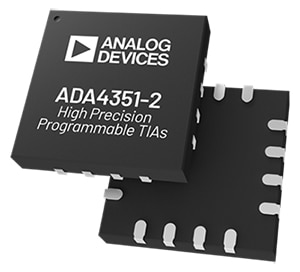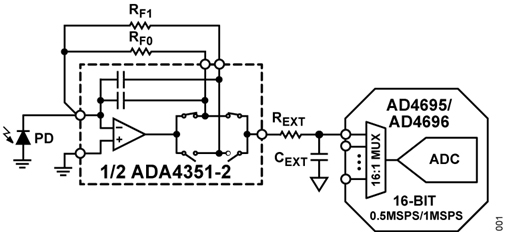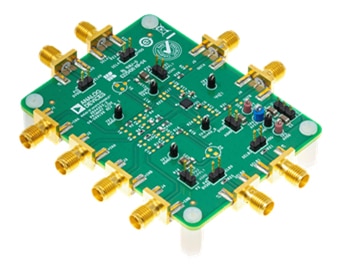可编程增益 TIA 为信号处理提供精密放大功能
投稿人:DigiKey 北美编辑
2025-01-09
将低电流信号转换为电压输出是多种应用的基本要求,尤其是那些依靠传感器转换物理现象以达到测量、监控和检测目的的应用。 当这些信号可预测且稳定时,跨阻放大器 (TIA) 是就一种相对简单、可靠的解决方案,但工程师们越来越需要一种更复杂解决方案,不仅具有精密放大功能,还能适应可变输入电流或高动态范围。
TIA 用于通过反馈电阻器将输入电流转换为输出电压。为将小电流转换为电压信号,这类放大器提供了一种相对简便且经济高效的方法。
这类放大器广泛用于将光、电荷或辐射等物理现象产生的电流转换为可测量的电压信号,且可以放大和调节这些电压信号,以便进行信号处理和远距离传输。因此,这类器件广泛应用于光纤通信、光和辐射检测、粒子探测、光探测和测距 (LiDAR)、医疗设备以及使用低功耗传感器的紧凑型系统。
然而,大多数 TIA 具有固定增益,无法适应波动或较宽的电流范围,从而限制了自身的动态性能。当电流电平不符合设计参数时,可能会导致信号失真、精度降低或性能受限。要使这类器件适应更多的变化或动态条件,就需要改造硬件和增加元件,因而增加了复杂性和功耗。
可编程增益 TIA (PGTIA) 可利用单放大器来应对诸如高灵敏度光学系统、精密分析仪器以及电化学和生物电信号检测等应用中遇到的宽动态范围。
与标准 TIA 不同,PGTIA 可针对特定信号范围优化增益,尽可能地提高输出信号强度,从而提高整个系统的信噪比 (SNR)。这些器件可以动态方式改变增益,从而放大微弱信号,并防止强信号使输出达到饱和。
PGTIA 能够适应不断变化的信号条件并以动态方式改变增益,因此适用于采用宽输入动态范围和高精度测量设备的应用。例如,PGTIA 可以动态方式适应用于测量可变反射光的 LiDAR 系统的信号水平。
单通道与双通道 PGTIA
单通道 PGTIA 适用于需要测量或检测单点信号的应用,如简单的运动检测器或条形码扫描仪。但许多应用需要适应性更强的解决方案,以提供更高的精度,进一步降低电子噪声,分析多个参数,并在快速发展的市场中实现出色的处理能力和适应性。
双通道 PGTIA 可同时处理来自两个独立输入源的信号,使设计人员能够整合差分检测、噪声消除和多参数分析等功能。与采用单独的单通道器件相比,将两个放大器通道集成到一个紧凑型封装中更具成本效益,而且可以减少对额外元件的需求。每个通道都可针对不同的输入范围进行优化,使设计人员的应用具有更大的通用性。
双通道 PGTIA 的其他优势还包括更高效的功耗、尽可能地减小分立元件组合可能产生的寄生效应,以及减少所需的电路板空间。双通道可用于各种不同的应用设计目的,例如:
- 同时从独立数据源获取数据,以提高效率
- 提供冗余测量,以提高可靠性
- 实现两个信号的对比测量
虽然双通道 PGTIA 的单位成本可能略高于单通道替代品,但更少的元件、更简化的装配和更优的质量控制可能会抵消这一成本。
高度集成且结构紧凑的 ADI PGTIA
Analog Devices, Inc.(ADI) 为诸如光网络设备、光电探测器接口和精密仪器等需要精密 PGTIA 的应用提供了紧凑灵活的解决方案。
ADA4351-2(图 1)是一款单片双通道 PGTIA,采用 3 mm x 3 mm 引线框架芯片级封装 (LFCSP),且无裸露焊盘。每个通道都有两个可选的反馈路径,每个反馈路径的增益均通过外部电阻器设置。
 图 1:ADI 的 ADA4351-2 PGTIA 为在宽动态范围内精确测量小电流提供了一种单片双通道器件选择。(图片来源:Analog Devices, Inc.)
图 1:ADI 的 ADA4351-2 PGTIA 为在宽动态范围内精确测量小电流提供了一种单片双通道器件选择。(图片来源:Analog Devices, Inc.)
ADA4351-2 可以满足许多依赖高精度、高灵敏度和高适应性的应用的需求。该器件具有多种功能,非常适合需要精确放大信号、高动态范围和集成功能的应用,如光通信、医学成像、光谱学和科学仪器。该器件的工作温度为 -40°C 至 +125°C.
ADA4351-2 设计紧凑,能够直接驱动模数转换器,因此能够简化系统架构、减少元件数量并提高可靠性。该器件可直接驱动两个 16 位精密 ADC(图 2,其中一个如图所示)。例如,ADI 的 AD4695 和 AD4696 为开发人员提供了用于电流精密测量应用的完整模拟前端。
 图 2:ADA4351-2 的 ½ 驱动 ADC(如 ADI 的 AD4695/AD4696)。(图片来源:Analog Devices, Inc.)
图 2:ADA4351-2 的 ½ 驱动 ADC(如 ADI 的 AD4695/AD4696)。(图片来源:Analog Devices, Inc.)
ADA4351-2 提供不同的模拟和数字输入,并且可由双极性电源供电,以便在完成高性能模拟任务的同时,保持与接地参考数字系统之间的无缝低噪声通信。数字电源可灵活地控制独立于模拟电源范围之外的开关逻辑。
该解决方案简化了混合信号环境的设计,因为 ADA4351-2 既可集成到要求高性能模拟处理能力的系统中,又可兼容低压数字控制逻辑。
该器件的模拟电路可使用单电源(2.7 V 至 5.5 V)或双电源(±1.35 V 至 ±2.75 V),以实现单向和双向输入信号。该器件可直接驱动参考电压高达 5.5 V 的 ADC。
数字输入可使用 1.62 V 至 5.5 V 的电源,因此兼容 1.8 V、3.3 V 或 5 V 常用逻辑电平,但具体取决于数字电源引脚(DVSS 和 DVDD)上的电压。
每个增益设置有两个集成的低关断泄漏专有开关,且采用开尔文配置,可减少 CMOS 开关的非理想性造成的误差。先进的开关技术使其成为许多应用的高效解决方案,与使用分立元件相比,可大大减少所需的 PCB 面积。
ADA4351-2 的增益带宽为 8.5 MHz,可处理高频信号。用户可对增益进行编程,以优化各种输入电流下的动态范围。
ADA4351-2 的原型开发和测试
使用 ADI 的 EVAL-ADA4351-2EBZ 评估板(图 3),设计人员可在转入定制 PCB 设计之前,使用 ADA4351-2 快速对应用进行原型设计、测试和优化。
 图 3:EVAL-ADA4351-2EBZ 配备了关键元件,使用户能够使用 ADA4351-2 PGTIA 运行和评估应用。(图片来源:Analog Devices, Inc.)
图 3:EVAL-ADA4351-2EBZ 配备了关键元件,使用户能够使用 ADA4351-2 PGTIA 运行和评估应用。(图片来源:Analog Devices, Inc.)
该电路板支持光电二极管接口、增益选择和其他应用的快速配置,因而成为针对光学、仪器和数据采集场景开发精密模拟前端系统的实用工具。
该电路板预先配置了演示 ADA4351-2 的主要功能所需的元件,包括可编程跨阻增益、低噪声工作和宽动态范围。每个通道都预留了一个光电二极管插槽,用于支持快速原型开发。
在位于输入和输出端的开放式电阻和电容封装上,可以安装具有用户定义值的元件,如低通滤波器 (LPF) 或分压器。边缘安装式 SMA 连接器和测试点可将测试设备直接连接至两个通道的输入和输出以及增益开关的控制引脚。
开发人员可以探索不同的配置,并使用自己的信号链组件(如 ADC 或光学传感器)测试放大器。
结论
利用 ADI 的 ADA4351-2 双通道 PGTIA,开发人员可以为各种光电二极管接口、光学、仪器和数据采集应用实现更精确、更可靠的性能。凭借集成开关、可编程增益和优异的噪声性能,该器件为同时处理来自独立输入源的信号提供了一种适应性强的、高效的解决方案。

免责声明:各个作者和/或论坛参与者在本网站发表的观点、看法和意见不代表 DigiKey 的观点、看法和意见,也不代表 DigiKey 官方政策。






